Role of Nurse in Childhood Obesity Prevention
Added on 2023-04-21
38 Pages9864 Words417 Views
Running head: NURSING DISSERTATION
Nursing dissertation
Name of the student:
Name of the University:
Author’s note
Nursing dissertation
Name of the student:
Name of the University:
Author’s note
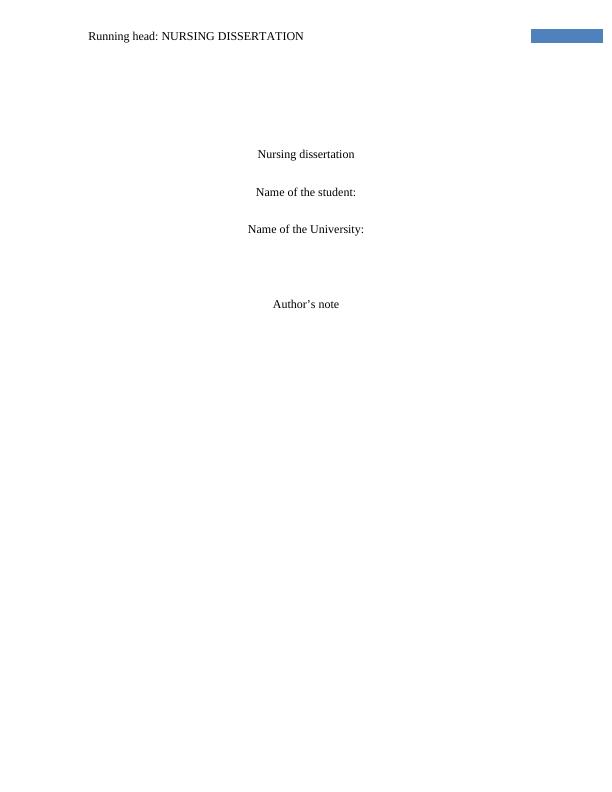
1NURSING DISSERTATION
Abstract
Background: Childhood obesity is a major health global health concern due to increase in
likelihood of serious illness for obese children. As nurses are actively involved in obesity
prevention program in schools, there is a need to review studies that evaluate
Aim: The aim of this systematic review is to critically examine nurse’s role in childhood obesity
prevention and interpret whether they are rightly positioned to reduce the risk factors of obesity
for children or not.
Method: The systematic review of research papers has been done based on review of CINAHL
and PubMed database. The articles published between 2013 to 2019 have been included in the
review and the data analysis has been using thematic approach.
Results: Based on screening of articles based on inclusion and exclusion criteria, a total of 7
articles were included in the review. Three themes emerged based on evaluation of nurse role in
childhood obesity prevention. This included role of nurse led obesity prevention in influencing
physical activity and healthy behaviours of children, in influencing BMI and Success of Nurse-
led obesity prevention intervention based on resources and availability of adequate support. The
evaluation of the seven research articles gives the insight that nurses are well-positioned to
deliver health promotion intervention for obese children. However, systematic review helped to
examine issues in school nurse led intervention design and weakness in research methodologies
that led to poor or unexpected outcomes for obese children. This systematic gives the implication
that nurses can be successful in preventing obesity if they are supported with right resource and
appropriate strategies are taken to ensure that parents and children comply with the education or
behavioural advice.
Abstract
Background: Childhood obesity is a major health global health concern due to increase in
likelihood of serious illness for obese children. As nurses are actively involved in obesity
prevention program in schools, there is a need to review studies that evaluate
Aim: The aim of this systematic review is to critically examine nurse’s role in childhood obesity
prevention and interpret whether they are rightly positioned to reduce the risk factors of obesity
for children or not.
Method: The systematic review of research papers has been done based on review of CINAHL
and PubMed database. The articles published between 2013 to 2019 have been included in the
review and the data analysis has been using thematic approach.
Results: Based on screening of articles based on inclusion and exclusion criteria, a total of 7
articles were included in the review. Three themes emerged based on evaluation of nurse role in
childhood obesity prevention. This included role of nurse led obesity prevention in influencing
physical activity and healthy behaviours of children, in influencing BMI and Success of Nurse-
led obesity prevention intervention based on resources and availability of adequate support. The
evaluation of the seven research articles gives the insight that nurses are well-positioned to
deliver health promotion intervention for obese children. However, systematic review helped to
examine issues in school nurse led intervention design and weakness in research methodologies
that led to poor or unexpected outcomes for obese children. This systematic gives the implication
that nurses can be successful in preventing obesity if they are supported with right resource and
appropriate strategies are taken to ensure that parents and children comply with the education or
behavioural advice.
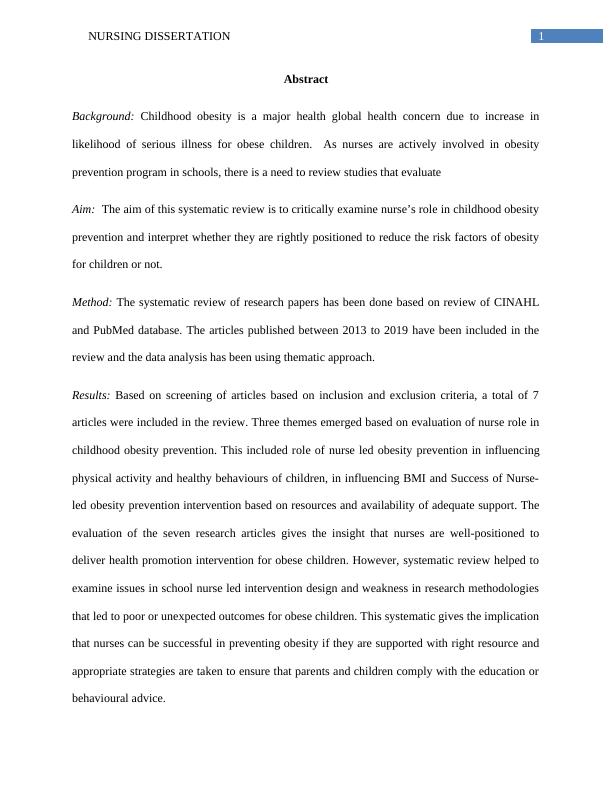
2NURSING DISSERTATION
Conclusion: To conclude, the study suggests many recommendations to enhance nurse’s role in
childhood obesity prevention. This involves proper training regarding implementation of
intervention, target changes in social norms and environment and developing resource in schools
and community to encourage physical activity in children.
Conclusion: To conclude, the study suggests many recommendations to enhance nurse’s role in
childhood obesity prevention. This involves proper training regarding implementation of
intervention, target changes in social norms and environment and developing resource in schools
and community to encourage physical activity in children.
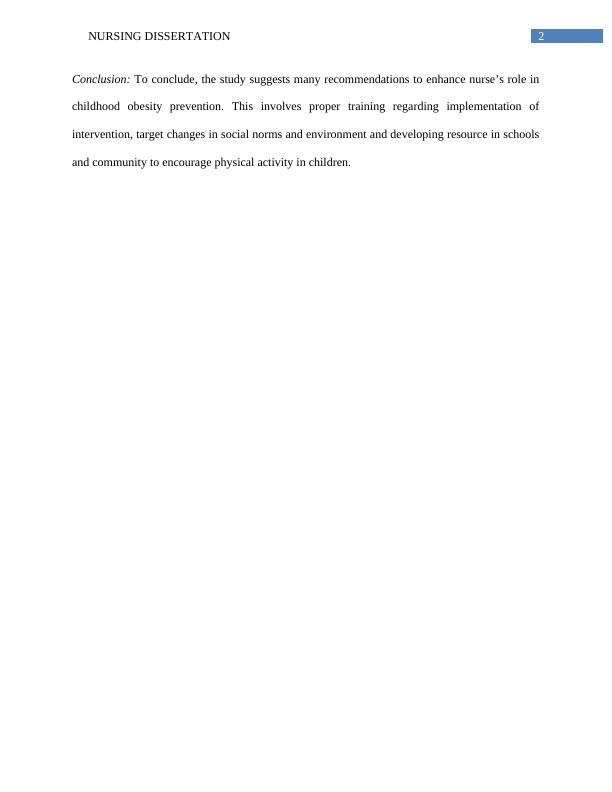
3NURSING DISSERTATION
Table of Contents
Chapter one......................................................................................................................................4
Chapter two......................................................................................................................................6
Chapter three....................................................................................................................................8
Chapter four...................................................................................................................................19
References:....................................................................................................................................24
Appendix:........................................................................................................................................0
Table of Contents
Chapter one......................................................................................................................................4
Chapter two......................................................................................................................................6
Chapter three....................................................................................................................................8
Chapter four...................................................................................................................................19
References:....................................................................................................................................24
Appendix:........................................................................................................................................0
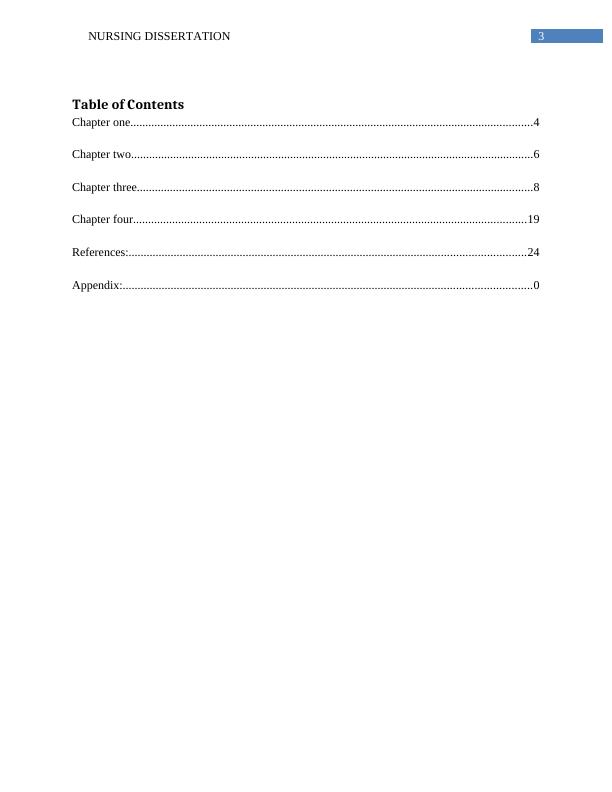
4NURSING DISSERTATION
Chapter one
Introduction:
Obesity is a condition leading to excessive fat accumulation in the body thus increasing
risk of other chronic disease in an individual. Obesity is a major global health burden because the
rate of obesity has tripled since 2015 (World Health Organization 2018). Apart from prevalence
of obesity in adulthood, the prevalence of obesity in childhood is a major concern because
childhood obesity has impact on nearly all organ system and it increases the likelihood of serious
consequences (diabetes, hypertension, psychosocial problem and fatty liver disease) for those
children in adulthood. For example, childhood obesity is associated with an increase in
atherosclerotic process, increased risk of cardiovascular disease and pulmonary disorder (Han,
Lawlor and Kimm 2010). The report by World Health Organization (2018) shows that 41 million
children under age of 5 were overweight or obese in 2016 and 340 million children between the
age group of 5 to 19 years were overweight or obese in 2016 globally. Hence, considering the
prevalence of childhood obesity, taking vital steps to prevent the risk of overweight or obesity is
important.
Obesity occurs as a result of imbalance between energy intake and expenditure. Some of
the risk factors that lead to childhood obesity include dietary intake, physical activity, sedentary
behaviour and influence of parenting styles (Sahoo et al. 2015). Hence, promoting healthy
behaviour in both children and parents are vital to decrease the obesity epidemic. Collins (2018)
supports that nurses are playing a key role in obesity interventions and the future will see more
nurses engaging with children to prevent obesity. As nurses are more in numbers and more
readily accessible compared to other health care professionals, considering the role of nurse in
Chapter one
Introduction:
Obesity is a condition leading to excessive fat accumulation in the body thus increasing
risk of other chronic disease in an individual. Obesity is a major global health burden because the
rate of obesity has tripled since 2015 (World Health Organization 2018). Apart from prevalence
of obesity in adulthood, the prevalence of obesity in childhood is a major concern because
childhood obesity has impact on nearly all organ system and it increases the likelihood of serious
consequences (diabetes, hypertension, psychosocial problem and fatty liver disease) for those
children in adulthood. For example, childhood obesity is associated with an increase in
atherosclerotic process, increased risk of cardiovascular disease and pulmonary disorder (Han,
Lawlor and Kimm 2010). The report by World Health Organization (2018) shows that 41 million
children under age of 5 were overweight or obese in 2016 and 340 million children between the
age group of 5 to 19 years were overweight or obese in 2016 globally. Hence, considering the
prevalence of childhood obesity, taking vital steps to prevent the risk of overweight or obesity is
important.
Obesity occurs as a result of imbalance between energy intake and expenditure. Some of
the risk factors that lead to childhood obesity include dietary intake, physical activity, sedentary
behaviour and influence of parenting styles (Sahoo et al. 2015). Hence, promoting healthy
behaviour in both children and parents are vital to decrease the obesity epidemic. Collins (2018)
supports that nurses are playing a key role in obesity interventions and the future will see more
nurses engaging with children to prevent obesity. As nurses are more in numbers and more
readily accessible compared to other health care professionals, considering the role of nurse in
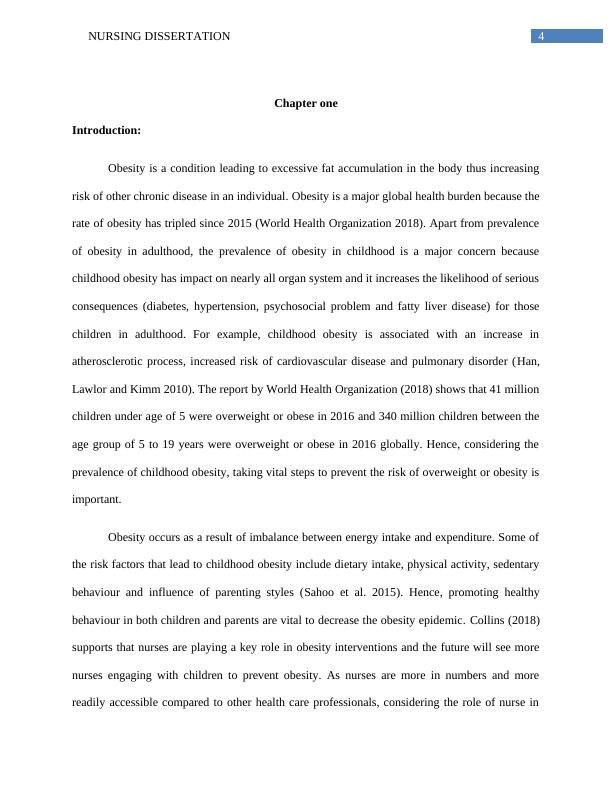
5NURSING DISSERTATION
addressing the epidemic is necessary. Recently there is an increase in participation of nurse in
childhood obesity prevention initiatives. Rabbitt and Coyne (2012) explain that nurse can engage
in partnership with parents and children by providing nutritional advice and offering strategies to
decrease caloric intake and physical activity. There are many evidences regarding the
participation of nurse in obesity prevention initiative and promoting behavioural change and
giving health behaviour related advice. However, gap in research is that no research has explored
the impact of nurse on preventing childhood obesity based on outcomes, barriers and facilitators
and process employed. Hence, the aim of this systematic review is to critically examine nurse’s
role in childhood obesity prevention and interpret whether they are rightly positioned to reduce
the risk factors of obesity for children or not. The PICO question for the systematic review is as
follows:
What is the role and contribution of nurse in preventing childhood obesity for children at
risk of overweight and obesity issues?
Population (P): Children with obesity
Intervention (Intervention): Role and contribution of nurse
Outcome: Prevention of childhood obesity
Comparator: No comparison
The main purpose of this dissertation report is to examine nurse’s role in prevention of
childhood obesity by systematic review. The focus is to evaluate the effectiveness of nurse in
influencing obesity related to outcome and behaviour of children and evaluating nurse’s
experience in delivering childhood obesity prevention program. The significance of research in
addressing the epidemic is necessary. Recently there is an increase in participation of nurse in
childhood obesity prevention initiatives. Rabbitt and Coyne (2012) explain that nurse can engage
in partnership with parents and children by providing nutritional advice and offering strategies to
decrease caloric intake and physical activity. There are many evidences regarding the
participation of nurse in obesity prevention initiative and promoting behavioural change and
giving health behaviour related advice. However, gap in research is that no research has explored
the impact of nurse on preventing childhood obesity based on outcomes, barriers and facilitators
and process employed. Hence, the aim of this systematic review is to critically examine nurse’s
role in childhood obesity prevention and interpret whether they are rightly positioned to reduce
the risk factors of obesity for children or not. The PICO question for the systematic review is as
follows:
What is the role and contribution of nurse in preventing childhood obesity for children at
risk of overweight and obesity issues?
Population (P): Children with obesity
Intervention (Intervention): Role and contribution of nurse
Outcome: Prevention of childhood obesity
Comparator: No comparison
The main purpose of this dissertation report is to examine nurse’s role in prevention of
childhood obesity by systematic review. The focus is to evaluate the effectiveness of nurse in
influencing obesity related to outcome and behaviour of children and evaluating nurse’s
experience in delivering childhood obesity prevention program. The significance of research in

6NURSING DISSERTATION
this area is that it will enable policy makers to understand the potential of nurse in influencing
eating and physical activity related behaviour of children and including more nurses in health
promotion program related to obesity prevention. In the personal areas of nursing practice, this
research will develop understanding regarding the key skills needed by nurse to engage in
obesity prevention initiatives for children. This dissertation will outline the strategy of literature
search in chapter two, present the research and its findings in chapter three. Chapter four will
discuss about the implications of the research findings and recommendations for improvement in
future practice or research. The final chapter five will provide conclusion for the research with a
brief summary on the whole research process.
Chapter two
Search and review strategy:
Introduction:
To find relevant research literatures related to the role of nurse’s in preventing childhood
obesity, systematic review of research papers were done with set of inclusion and exclusion
criteria and going through the process of identification, screening, eligibility and inclusion of
research papers in the study. The main advantage of following systematic review is that it helps
to follow a systematic approach during literature search and summarize the results of high
quality health care studies to inform health care practices and improve patient care (Moher et al.
2015). The dissertation uses thematic approach to report about key findings from the review and
uses specific technique to interpret the quality of the studies. This chapter will give detail
regarding the search process, search terms used and method used to select articles from
databases.
this area is that it will enable policy makers to understand the potential of nurse in influencing
eating and physical activity related behaviour of children and including more nurses in health
promotion program related to obesity prevention. In the personal areas of nursing practice, this
research will develop understanding regarding the key skills needed by nurse to engage in
obesity prevention initiatives for children. This dissertation will outline the strategy of literature
search in chapter two, present the research and its findings in chapter three. Chapter four will
discuss about the implications of the research findings and recommendations for improvement in
future practice or research. The final chapter five will provide conclusion for the research with a
brief summary on the whole research process.
Chapter two
Search and review strategy:
Introduction:
To find relevant research literatures related to the role of nurse’s in preventing childhood
obesity, systematic review of research papers were done with set of inclusion and exclusion
criteria and going through the process of identification, screening, eligibility and inclusion of
research papers in the study. The main advantage of following systematic review is that it helps
to follow a systematic approach during literature search and summarize the results of high
quality health care studies to inform health care practices and improve patient care (Moher et al.
2015). The dissertation uses thematic approach to report about key findings from the review and
uses specific technique to interpret the quality of the studies. This chapter will give detail
regarding the search process, search terms used and method used to select articles from
databases.
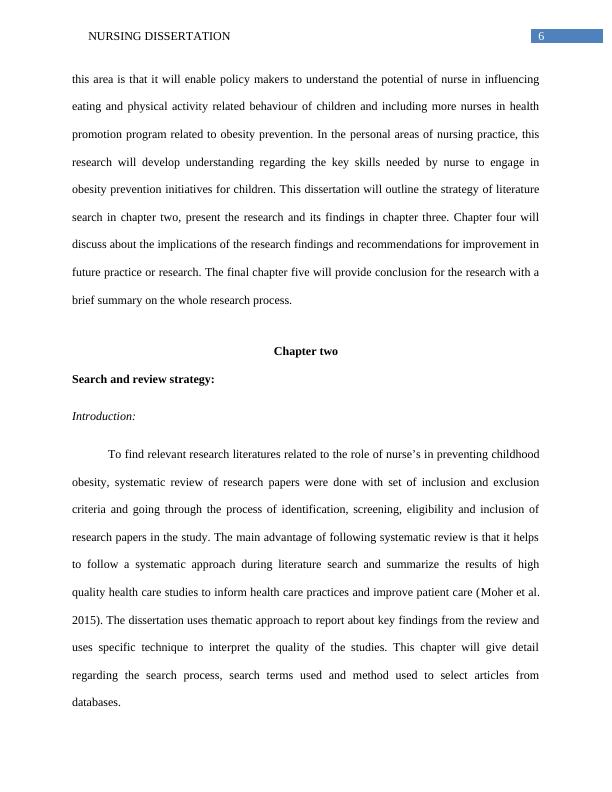
7NURSING DISSERTATION
Search strategy: To find relevant articles related to the topic of investigation, the search for
literatures were done in CINAHL and PubMed database. The main reason behind taking these
databases in systematic review is that both the database published peer review research articles
based on biomedical, health care and nursing research. Hence, searching for papers in this
database increases the likelihood of getting as many high quality research papers. The key terms
that helped to retrieve relevant articles related to the research topics included ‘nursing’, ‘obesity’,
‘children’, ‘teenagers’, ‘adolescents’, ‘weight’ and ‘obesity prevention’. The key search filters
that were used to refine the search process included the source, language and data of
publications. The source selected was peer-reviewed journals only and language selected was
English.. The search was performed in the database for articles published between 2010 to 2019.
Inclusion and Exclusion criteria:
The following inclusion and exclusion criteria helped to retrieve appropriate articles as
per the purpose of investigation:
1. Types of study: As the main purpose of this research is to examine the role of nurse in
childhood obesity, all types of research papers including both primary and secondary
research will be included in the review.
2. Research participant: Only those papers were reviewed were nurses were involved in
health promotion for children or teenagers. The studies reporting about the role of social
workers or other health promotion staffs were excluded.
3. Outcome: The research must report about outcomes in obese children like improvement
in preventive behaviours like increase in physical activity, reduction in weight,
modification in weight and experiences related to change in lifestyle.
Search strategy: To find relevant articles related to the topic of investigation, the search for
literatures were done in CINAHL and PubMed database. The main reason behind taking these
databases in systematic review is that both the database published peer review research articles
based on biomedical, health care and nursing research. Hence, searching for papers in this
database increases the likelihood of getting as many high quality research papers. The key terms
that helped to retrieve relevant articles related to the research topics included ‘nursing’, ‘obesity’,
‘children’, ‘teenagers’, ‘adolescents’, ‘weight’ and ‘obesity prevention’. The key search filters
that were used to refine the search process included the source, language and data of
publications. The source selected was peer-reviewed journals only and language selected was
English.. The search was performed in the database for articles published between 2010 to 2019.
Inclusion and Exclusion criteria:
The following inclusion and exclusion criteria helped to retrieve appropriate articles as
per the purpose of investigation:
1. Types of study: As the main purpose of this research is to examine the role of nurse in
childhood obesity, all types of research papers including both primary and secondary
research will be included in the review.
2. Research participant: Only those papers were reviewed were nurses were involved in
health promotion for children or teenagers. The studies reporting about the role of social
workers or other health promotion staffs were excluded.
3. Outcome: The research must report about outcomes in obese children like improvement
in preventive behaviours like increase in physical activity, reduction in weight,
modification in weight and experiences related to change in lifestyle.
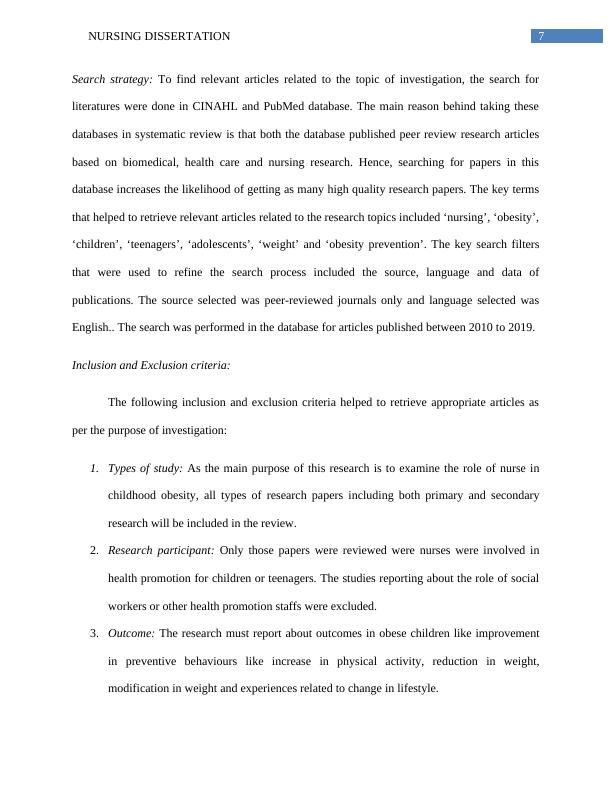
End of preview
Want to access all the pages? Upload your documents or become a member.
Related Documents
Effective Interventions for Preventing Childhood Obesity in School Age Childrenlg...
|38
|7007
|45
Research Topic | Prevent Overweight among Childrenlg...
|67
|13599
|15
Assignment on Effectiveness of School-based Interventions to Preventlg...
|55
|12765
|17
Health Promotion Plan Assignment 2022lg...
|9
|2928
|39
Societal Infant Problems: Childhood Obesitylg...
|20
|4013
|79
Development of a Community Health Promotion Programlg...
|13
|3481
|22
